Should you focus on high reps low weight, or low reps high weight?
After reading this post, you’ll learn:
- What rep range is best for building muscle,
- If high reps or low reps are better fat loss, and
- How many reps you should do for best results.
Let’s dive right in.
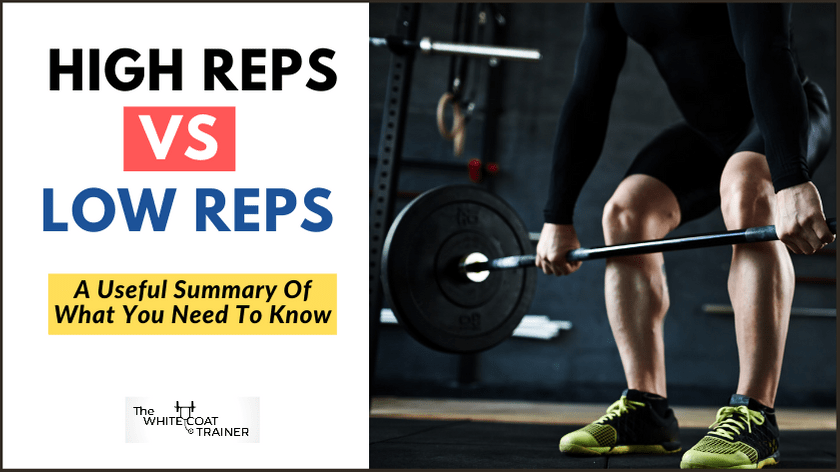
Is it better to do low weight high reps or high weight low reps?
For the vast majority of people, high reps with low weight are better, primarily from a safety standpoint.
It is much easier to perform exercises with proper form using a weight that isn’t excessively heavy.
With that said, you can build similar amounts of muscle with both high reps / low weight and low reps / high weight. (Assuming that the total number of reps is similar!)
The key difference is that low reps with heavy weights are better for building absolute strength.
That is why I recommend that you use a combination of all rep ranges for the best results.
Let’s go over this in more detail.
The Benefits of High Repetitions
There are three major benefits of lifting with light weights and high reps.
- First, high reps allow you to do more volume in less time. Volume is the key to increasing muscle mass.
It is much easier to build muscle doing sets of 8 repetitions compared to sets of 3 repetitions.
- Second, it is much easier to maintain proper form when the weight load is “light.”
You must use proper form to activate the right muscles appropriately. Improper technique can lead to pain, injury, and frustration.
- Third, it is much easier to maintain an efficient workout using higher reps.
Fewer sets are needed to accumulate a sufficient amount of training volume for growth.
In addition, you can keep your rest periods shorter using lighter loads compared to heavier loads.
Now let’s go over the most common question regarding high repetitions.
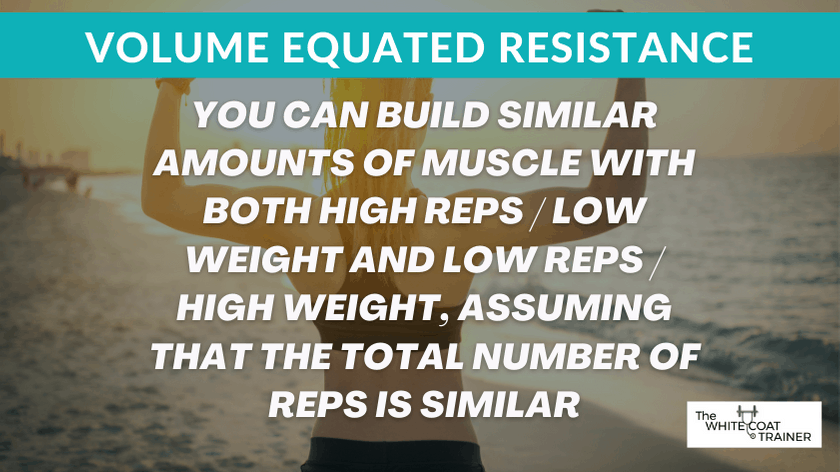
What is the best way to build muscle with low weight high reps?
It is possible to build muscle using low weight, provided that you train with enough volume and intensity.
The amount of weight on the bar needs to be heavy enough to cause muscular failure in the 8-15 repetition range.
Keep your rest periods to no more than 90 seconds between sets.
You should also perform at least 25 repetitions per muscle group, two times per week.
Are high reps better for definition / toning?
There is a common misconception that high reps are better for improving definition.
The only way to increase muscle tone is to get leaner.
This includes dropping your body fat percentage while increasing your muscle size. This can be done with a wide range of repetitions.
High reps are not needed for definition or toning.
Instead, I recommend cycling through the higher reps, moderate reps, and low rep sets to get all the benefits of weight training.
How Many Reps Is Too High?
Performing sets above 20 repetitions are probably too high for any significant muscle growth. That’s because you need to provide your muscles with enough intensity to induce muscle hypertrophy.
Beyond 20 reps, you are improving your muscular endurance rather than muscle size or strength.
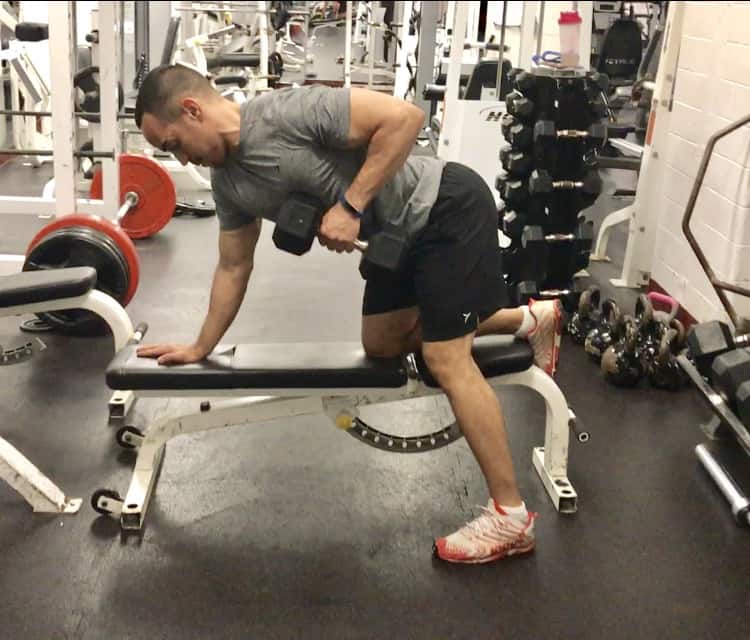
Can you build muscle with 20 reps?
Sure. But from a sustainability standpoint, it’s better to do fewer reps. Stick to the 8-15 rep range.
Okay, now let’s talk about low reps.
The Benefits of Lower Reps
If you are looking to build some strength through resistance training, then low repetitions will offer you some unique benefits.
- Low repetitions with heavier weight will force your central nervous system to work more efficiently at producing force. This is how you produce a lot of power.
- Secondly, low repetitions allow you to build significant amounts of strength. This is crucial if you want to improve your one-rep max bench press or achieve your first pull-up.
- Thirdly, low repetitions allow you to break any plateaus you might experience from using lighter weights all the time. Your body is great at adapting. If you only stick to one rep range, your progress will eventually stall.
I consider anything where you cannot perform more than 4-6 repetitions per set to be part of the lower rep range.
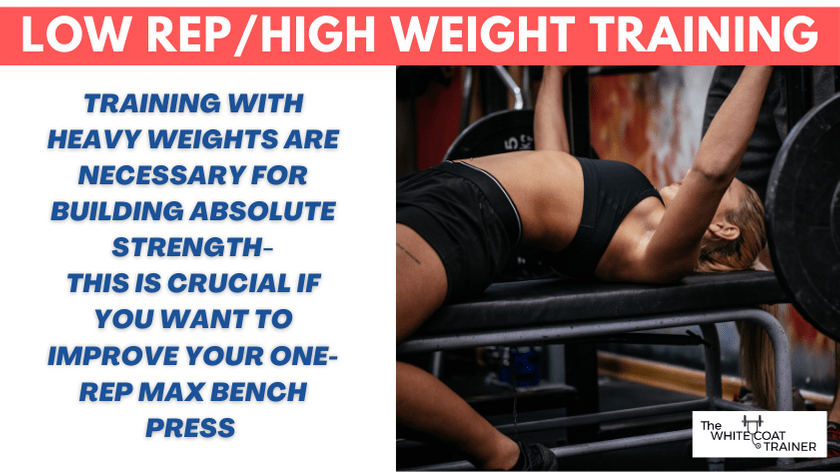
Do you need to lift heavy for hypertrophy?
You do not have to lift heavy to induce muscular hypertrophy, but lifting heavy will increase your absolute strength.
This is beneficial because you will be able to lift heavier weights in the 8-15 rep range after building a good baseline of strength.
This is why I recommend that you do a strength training block every once in a while where you perform ~5 reps per set on your top sets.
A bigger muscle has the potential to become a stronger muscle.
The opposite is also true.
A stronger muscle has the potential to become a bigger muscle.
The downside of only lifting with low reps
There are two reasons why you might not want to lift heavy.
They are:
Injury risk
In order for low rep training to be meaningful – the weight on the bar has to be very challenging.
Although this is good for strength gains, there are some downsides.
If you only lift heavy for weeks and weeks you will achieve good results, but your joints can take a beating.
There are two outcomes
- Best case scenario – you end up feeling beat up.
- Worst case scenario- you can significantly increase your risk of injury.

Less time efficient
When using heavy loads, you will need longer rest periods between sets.
Your central nervous system needs time to recover in addition to your muscles.
In general, you might need 3-4 minutes of rest after a heavy set.
Should I mix high reps with low reps?
It’s a good idea to mix up your routine between high reps and low reps throughout your training.
I often recommend a protocol like this:
- 8-12 weeks of hypertrophy training focusing on the 7-12 rep range
- 4-8 weeks of strength training focusing on the 4-6 rep range
- 4 weeks of training focusing on the 1-3 rep range (if you are interested in pursuing strength)
- OR 4 weeks of training focusing on the 12-15 rep range (if you are interested in building endurance).
That way, you get all the benefits of the different rep ranges.
Other Related Questions
Which Is Better For Fat Loss? High reps vs low reps?
Fat loss will always be a nutrition-based endeavor. It doesn’t matter how many repetitions you do if you don’t clean up your diet.
With that said, high reps will allow you to burn more calories during the actual workout. This is why cardio-based exercises burn the most calories.
But don’t be fooled. 30 minutes of weight lifting will only burn 90-250 calories total.
You can consume 250 calories in 5 seconds!
This is why nutrition will always be more important than exercise when it comes to weight loss.
If you clean up your diet, stick to the 8-20 rep range for fat loss.
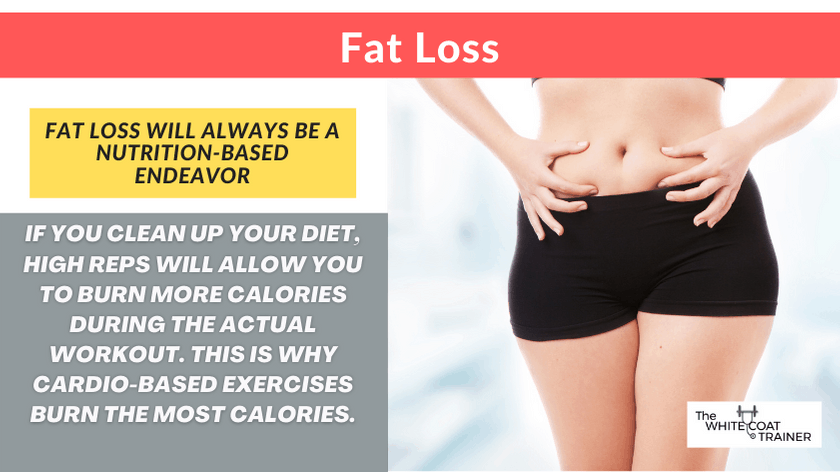
What Exercises Should You Do?
Okay now that you know which rep scheme you are going to use – we have to discuss the best exercises.
In general there are 6 compound exercises you need to do to hit all the major muscle groups in the body.
These include
- The horizontal push
- The horizontal pull
- The vertical push
- The vertical pull
- The knee flexion
- The hip extension
I go over all the different ways you can train these patterns in this post.
Do Muscle Fibers Respond Differently To Different Rep Ranges?
It is believed that type 1 aka slow twitch muscle fibers responds better to high rep low weight training. On the other hand type II fast twitch fibers respond better to low rep high weight training.
As a result, it’s unlikely that you will know which fibers are predominant in your specific muscle tissue.
The bottom line?
Don’t worry about muscle fibers. Use both the high rep range and the low rep range throughout your training.
Final Words On The High Reps Vs Low Reps Debate
Whether you’re looking to build muscle, gain strength, or improve endurance, it is important that you train with a style and intensity that best suits your goals.
Low-rep training is great for building strength and breaking through plateaus while high rep training is good for building muscle mass and increasing endurance.
So what’s the best rep range?
All of them!
Now I want to hear from you.
Which style of training do you prefer?
Comment below and let me know.
Related Articles:
- How Many Sets Should You Do?
- Strength Vs Hypertrophy: Which Should You Focus On?
- How Much Weight Should You Lift?

Alex Robles, MD, CPT / Brittany Robles, MD, MPH, CPT
Alex & Brittany Robles are physicians, NASM Certified Personal Trainers, and founders of The White Coat Trainer: a resource dedicated to improving the health and fitness of busy professionals using time-efficient strategies. Their advice has been featured in My Fitness Pal, Prevention, Livestrong, Reader’s Digest, Bustle, The Active Times, and more. Learn more about them here.
References:
- Schoenfeld BJ, Ratamess NA, Peterson MD, Contreras B, Sonmez GT, Alvar BA. Effects of different volume-equated resistance training loading strategies on muscular adaptations in well-trained men. J Strength Cond Res. 2014 Oct;28(10):2909-18. doi: 10.1519/JSC.0000000000000480. PMID: 24714538.
- Schoenfeld BJ, Peterson MD, Ogborn D, Contreras B, Sonmez GT. Effects of Low- vs. High-Load Resistance Training on Muscle Strength and Hypertrophy in Well-Trained Men. J Strength Cond Res. 2015 Oct;29(10):2954-63. doi: 10.1519/JSC.0000000000000958. PMID: 25853914.
- Schoenfeld BJ, Contreras B, Vigotsky AD, Peterson M. Differential Effects of Heavy Versus Moderate Loads on Measures of Strength and Hypertrophy in Resistance-Trained Men. J Sports Sci Med. 2016;15(4):715-722. Published 2016 Dec 1.
- Schoenfeld, Brad J The Mechanisms of Muscle Hypertrophy and Their Application to Resistance Training, Journal of Strength and Conditioning Research: October 2010 – Volume 24 – Issue 10 – p 2857-2872 doi: 10.1519/JSC.0b013e3181e840f3
